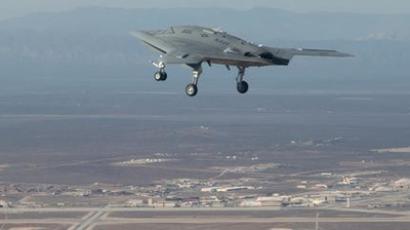Drone hack explained: Professor details UAV hijacking
Todd Humphreys’ tale about hacking a civilian drone in front of the Department of Homeland Security has gone viral since he conducted the experiment last month. Now the assistant professor at the University of Texas explains his work to RT.
In an interview with RT America this week, Todd Humphreys of the University of Texas at Austin’s Radionavigation Laboratory reveals that it only took a few researchers, around $1,000 in parts and some seriously smart software to send signals to an unmanned aerial vehicle’s GPS receiver, hijack the craft in mid-air and then have it do the department’s bidding — all right in front of Homeland Security agents.“The navigations systems of these drones have a variety of sensors,” explains Humphreys, “…but at the very bottom is a GPS unit — and most of these drones that will be used in the civilian airspace have a civilian GPS unit which is wide open and vulnerable to this kind of attack. So if you can commander the GPS unit, then you can basically spoon feed false navigation information to the navigation center of these drones.”By compiling several years’ worth of research into custom-made software, Humphreys was able to do exactly that recently — and right before the DHS. By 2020, the Federal Aviation Administration expects to have as many as 30,000 drones flying over the United States. According to Humphreys, though, the FAA might want to make a few changes before they roll out a domestic UAV for local law enforcement agencies to use.“I’m a big proponent of bringing in drones to the national airspace. They are going to come and we might as well expect it. The question is, how can we bring them in reliably?” he asks. “And right now the dangers of bringing them in, before addressing this problem, is that someone on the ground could hack the drones and turn them into their own device, making them go to a different place or along a different path. So it could cause loss of life, it could cause collisions. But I hope that we can address the problem long before that happens.”Humphreys explains to RT that he went into the experiment expecting a real challenge by hacking the drone’s GPS with a homemade spoofer device, but along with some students, he says he “worked hard to demonstrate that it was indeed possible, and perhaps within the capability of other hackers.”“I think the vast majority of Americans are fascinated by drones,” he adds, “But there is a lack of deep understanding of the inner workings of the technology and perhaps of the safety threats,” which his team is now hoping to highlight by experiments such as these. Also up for discussion, he stresses, is the issue of privacy. “I’ve got some tall fences around the back of my house and I have a reasonable expectation of privacy when I’m having a barbecue in the back of the house, so of course I wouldn’t like to have any drone surveying me and my family as were having a barbecue, but I’d like to see these kinds of concerns balanced with the kind of economic benefit that drones can bring,” he says. “So whereas we’d like to welcome them in, we have to address problems of privacy. Now we have to address problems of safety before 2015 when the FAA opens these skies up to drones. “














